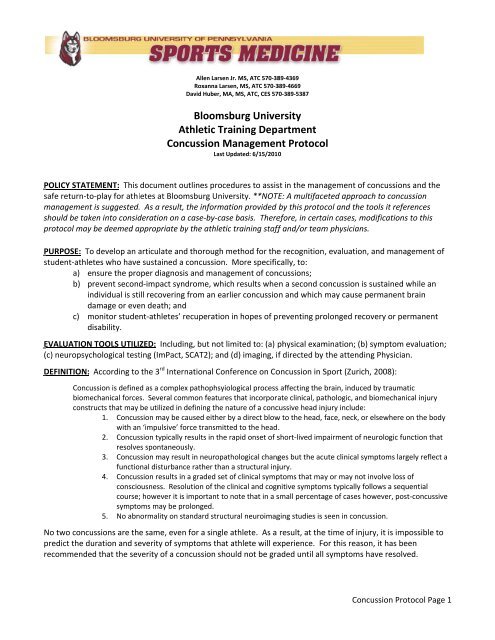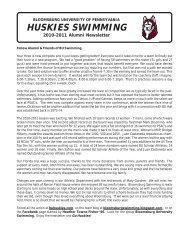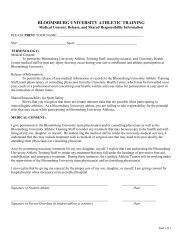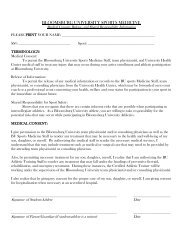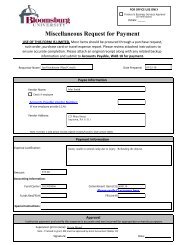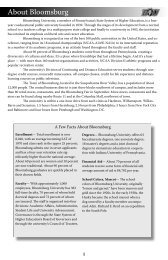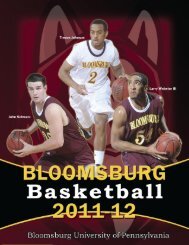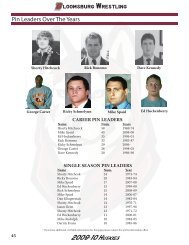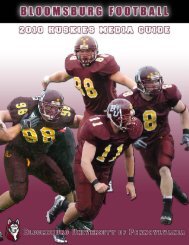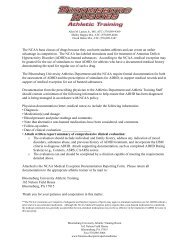Bloomsburg University Concussion Management Protocol
Bloomsburg University Concussion Management Protocol
Bloomsburg University Concussion Management Protocol
You also want an ePaper? Increase the reach of your titles
YUMPU automatically turns print PDFs into web optimized ePapers that Google loves.
Allen Larsen Jr. MS, ATC 570‐389‐4369<br />
Roxanna Larsen, MS, ATC 570‐389‐4669<br />
David Huber, MA, MS, ATC, CES 570‐389‐5387<br />
<strong>Bloomsburg</strong> <strong>University</strong><br />
Athletic Training Department<br />
<strong>Concussion</strong> Managemen<br />
nt <strong>Protocol</strong><br />
Last Updated: 6/15/2010<br />
POLICY STATEMENT: This document outlines procedures to assist in the management of concussions and the<br />
safe return‐to‐play for athletes at <strong>Bloomsburg</strong> <strong>University</strong>. **NOTE: A multifaceted approach to concussion<br />
management is suggested.<br />
As a result, the information provided by this protocol and the tools it references<br />
should be taken into consideration on a case‐by‐casee basis. Therefore, in certain cases, modifications to<br />
this<br />
protocol may be deemed appropriate by<br />
the athletic training staff<br />
and/or team<br />
physicians.<br />
PURPOSE: To<br />
develop an articulate and<br />
thorough method for thee recognition, evaluation, and management of<br />
student‐athletes who have<br />
sustained a concussion. More specifically, to:<br />
a) ensure the proper diagnosis and management of concussions;<br />
b) prevent second‐impact syndrome, whichh results when a second concussion is sustained while an<br />
individual is still recovering from an earlier concussion and which may cause permanent brain<br />
damage or even death; and<br />
c) monitor student‐athletes’ recuperation<br />
in hopes of preventing prolonged recovery or permanent<br />
disability.<br />
EVALUATION TOOLS UTILIZED: Including, but not limited to: (a) physical examination; (b) symptom evaluation;<br />
( c) neuropsychological testing (ImPact, SCAT2); and (d) imaging, if directed by the attending Physician.<br />
DEFINITION: According to the 3 rd International Conference on <strong>Concussion</strong> in Sport (Zurich,<br />
2008):<br />
<strong>Concussion</strong> is defined as a complex<br />
pathophsyiological processs affecting the brain, inducedd by traumatic<br />
biomechanical forces. Several common features<br />
that incorporate clinical, pathologic, and biomechanical injury<br />
constructs that may be utilized in defining the nature of a concussive head injury include:<br />
1. <strong>Concussion</strong> may be caused either by a direct bloww to the head, face, neck, or elsewhere on the body<br />
with an<br />
‘impulsive’ force transmitted to the head.<br />
2. <strong>Concussion</strong> typically results in the rapid onset of short‐lived impairment of neurologic function that<br />
resolves spontaneously.<br />
3. <strong>Concussion</strong> may result in neuropathological changes but the acute clinical symptoms largely<br />
reflect a<br />
functional disturbance rather than a structural injury.<br />
4. <strong>Concussion</strong> results in a graded set of clinical symptoms that may or may not involve loss of<br />
consciousness. Resolution of the clinical and cognitive symptoms typically follows a sequential<br />
course;<br />
however it is important to note that in a small percentage of cases however, post‐concussive<br />
symptoms may be prolonged.<br />
5. No abnormality on standard structural neuroimaging studies is seen in concussion.<br />
No two concussions are the same, even<br />
for a single athlete. As a result, at the<br />
time of injury, it is impossible to<br />
predict the duration and severity of symptoms that athlete will experience. For this reason, it has been<br />
recommended that the severity of a concussion should not be graded until all symptoms have resolved.<br />
<strong>Concussion</strong> <strong>Protocol</strong> Page 1
TIMELINE:<br />
PRE‐SEASON<br />
Athletes will be educated on the signs, symptoms, and risks associated with concussions. Prior to the first<br />
practice (or the first contact practice), all athletes must have a completed baseline assessment on file with the<br />
athletic training department. This assessment will include a detailed concussion history as well as<br />
neuropsychological and postural‐stability testing. All athletes will also sign a statement accepting the<br />
responsibility of reporting their injuries and illnesses to the athletic training staff.<br />
Baseline Assessment: The baseline assessment will consist of two parts: (1) a detailed concussion<br />
history and (2) neuropsychological testing. The student‐athlete will only need to complete the baseline<br />
assessment once during his/her tenure at <strong>Bloomsburg</strong> <strong>University</strong>. Those athletes participating in<br />
baseball, basketball, football, lacrosse, soccer, softball, and wrestling, or who report prior concussion(s),<br />
will need to complete the Baseline <strong>Concussion</strong> Evaluation. Because of the low risk nature of the sport,<br />
those athletes participating in cross country/track, swimming, and tennis will not be required to<br />
complete the Baseline <strong>Concussion</strong> Evaluation. The neuropsychological tests have all been shown to be<br />
reliable in assisting with the diagnosis of concussion as well as the monitoring recovery of athletes<br />
following concussions.<br />
ACUTE / TIME OF INJURY<br />
All student‐athletes identified as having a concussion will be held out from participation for the remainder of the<br />
day and will not return to participation until all signs and symptoms have resolved and the student‐athlete has<br />
completed the return‐to‐play progression.<br />
Common signs and symptoms of concussion may include, but are not limited to:<br />
SYMPTOMS<br />
Physical Cognitive Emotional<br />
Headache<br />
Dizziness<br />
Nausea<br />
Balance difficulties<br />
Light sensitivity<br />
Double vision<br />
Fatigued<br />
Feeling dazed, stunned, dinged<br />
Ringing in the ears<br />
Loss of/Impaired consciousness<br />
Poor coordination or balance<br />
Inappropriate emotions<br />
Vacant stare/Glassy eyed<br />
Inappropriate behavior<br />
Personality changes<br />
Confusion<br />
Amnesia<br />
Disorientation<br />
Poor concentration<br />
Memory disturbance<br />
Reasoning difficulties<br />
PHYSICAL SIGNS<br />
Poor coordination or balance<br />
Slow to answer questions<br />
Vomiting<br />
Slurred speech<br />
Significantly decreased performance<br />
Irritability<br />
Sadness<br />
Nervousness<br />
Depression<br />
Moodiness<br />
Sleep disturbances<br />
Concussive convulsion<br />
Seizure<br />
Slow to follow directions<br />
Easily distracted, Poor concentration<br />
At the time of injury, an Acute <strong>Concussion</strong> Assessment will be completed. A SCAT2 test may also be conducted if<br />
deemed necessary by the athletic training staff.<br />
The student‐athlete will be transported to the emergency room for evaluation and imaging if he/she<br />
experiences: (1) prolonged loss of consciousness (>1 minute), (2) significant alteration or deterioration in<br />
condition or mental status, (3) an increase in symptoms, or (4) if there is any concern that he/she may have a<br />
subdural hematoma.<br />
The athletic trainer will provide the athlete with Home <strong>Management</strong> Plan/Instructions and, when necessary,<br />
arrange for appropriate care by a responsible adult.<br />
<strong>Concussion</strong> <strong>Protocol</strong> Page 2
For at least the first 24 hours following a concussion, the athlete should not consume any alcohol or drugs.<br />
Depending on the state of the athlete, it may be recommended that he/she does not drive for the first 24 hours.<br />
POST‐CONCUSSION FOLLOW‐UP<br />
The athlete and athletic trainer will complete a <strong>Concussion</strong> Symptom Evaluation every day, or as needed, to<br />
monitor symptoms and recovery. Student‐athletes should be reminded to abstain from doing any activity that<br />
causes symptoms to increase. Other staff/faculty will be notified on an “as needed” basis in order to assist the<br />
athlete with daily activities until the athlete is no longer symptomatic. If the athlete is still experiencing five or<br />
more symptoms with a severity of three or above 72 hours after the injury, he/she will be referred to a<br />
physician.<br />
Neuropsychological Testing<br />
Once the student‐athlete reports he/she is symptom free, he/she will complete the Impact test.<br />
Neuropsychological tests will not be administered on consecutive days to limit learning curves. Once the athlete<br />
is symptom free and all tests are within normal limits (WNL), the Functional Progression may begin.<br />
RETURN‐TO‐PLAY (RTP)<br />
FUNCTIONAL PROGRESSION<br />
This protocol should not be initiated until the athlete is asymptomatic and all scores are WNL on all measures<br />
unless compelling evidence suggests otherwise. If signs or symptoms appear during a functional test, the test<br />
should be stopped immediately and the student‐athlete monitored until all signs or symptoms resolve. No<br />
further functional testing should be preformed that day. If symptoms do not resolve, the physician should be<br />
consulted and appropriate medical attention should be provided. When the athlete is again symptom free,<br />
he/she will need to move back at least one phase in the progression and begin again from there.<br />
After each phase of functional testing, the presence of post‐concussive symptoms should be assessed using the<br />
symptom evaluation scale. Progression to the next phase will require the athlete to remain symptom‐free.<br />
Phase 1: Mental Activity<br />
‐Reading, studying, etc<br />
Phase 2: Light, aerobic exercise, no resistance training<br />
‐Stationary bike: 10‐20 min<br />
Phase 3: Moderate aerobic exercise, no resistance training<br />
‐Continuous jogging: 10‐20 min, target HR > 140‐170 bpm<br />
Phase 4: Sprinting (anaerobic exertion) and weight training<br />
‐Minimum of 5 sprints of 30 yards, and resistance training<br />
Phase 5: Non‐contact agility drills, non‐contact practice<br />
‐Dribbling, shooting, walk‐through, skill enactment activities<br />
Phase 6: Full‐contact practice<br />
‐Have athlete continue to complete symptom evaluation scale after a minimum of 3 practice<br />
days and 1 competition<br />
Athletes will not return to full participation until they have been cleared by a physician recommended by the<br />
athletic training staff or his/her designee. The student athlete can only be cleared to return to play by an<br />
athletic trainer in accordance with a team physician of <strong>Bloomsburg</strong> <strong>University</strong>.<br />
STUDENT‐ATHLETES WITH MULTIPLE CONCUSSIONS WITHIN 365 DAYS<br />
Student‐athletes who sustain a second concussion within the same competitive season or an adjacent season<br />
should not begin the Functional Progression until he/she has been asymptomatic for 7‐10 days and all testing<br />
scores have returned to WNL. This athlete will not be allowed to return to full‐contact participation until 15<br />
days have passed since all testing scores returned to WNL.<br />
<strong>Concussion</strong> <strong>Protocol</strong> Page 3
Should a student‐athlete sustain a third concussion within the same competitive season, or a subsequent season<br />
within that school year (or 365 days, whichever is greater), he/she will be excluded from competition for the<br />
remainder of those days.<br />
<strong>Concussion</strong> <strong>Protocol</strong> Page 4


